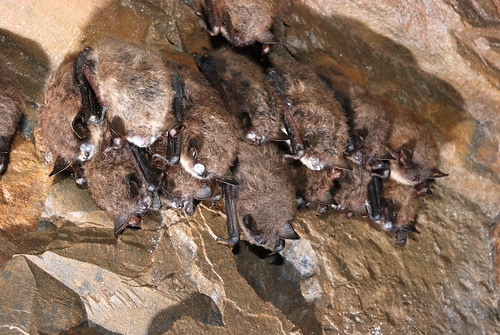The metal gate blocking the entrance to Cliff Cave in south St. Louis County allows Indiana bats to fly in and out but keeps humans from entering.
But on a Friday night in August, about 30 visitors had the opportunity to make like bats, slide through a tiny opening in the gate, and enter a place where they could imagine steamboats engulfed in flames on the St. Louis riverfront.
St. Louis County Parks was hosting an event, Stories in the Cave, that provided attendees a rare opportunity to enter Cliff Cave, which the department has blocked to protect the endangered bats (see our sidebar).
Such a cave “is an amazing part of nature, and I think people need to learn more about it, so they can appreciate it, and they will want to protect it as well.” said Laura MacLeod, a St. Louis County park ranger who led the event.
The county parks department held the storytelling event for the third time in August. Tickets were only $8.
Attendees met in the parking lot at Cliff Cave County Park at dusk and carried chairs and flashlights or headlamps for the 10-minute hike to the cave.
Inside, Barnes Bradshaw, the proprietor of Historically Speaking, stood ready to deliver stories. In addition to his business, the professional storyteller also worked for the county parks department as a museum educator at Jefferson Barracks and Faust Park and at the Missouri Historical Society as an events coordinator.
He explained to the audience that, while he also tells fictional tales, “the true stories are the ones that amazed me most.”
Bradshaw spoke about the Great Fire of 1849, a disaster along the St. Louis riverfront that destroyed 430 buildings, 23 steamers, nine flat boats, and several barges, according to St. Louis Fire Department history.
Bradshaw wore a period-appropriate coat, vest, and green tie and was illuminated by a spotlight. He first ensured the spelunkers realized they weren’t in a cave but rather in the 19th century along the waterway.
“I’m not a ghost from the past that has come back to visit you; you have come back to visit me. We are standing along the Mississippi River — why, you can hear it rolling by,” Bradshaw said, gesturing behind him to the cave wall, which unfortunately had been covered in graffiti. The sound of actual water flowed in the background.
Bradshaw introduced himself as a fireman who worked for the city, which was the second fire department in the country to pay its firefighters.
“I saved over 10 people that night. I didn’t have time to count, believe you me. I was simply doing my job,” Bradshaw explained.
Much of the city was destroyed. In response to the fire, the city required that all new buildings be constructed with fireproof material such as brick and stone, which still defines the look of the riverfront.
“I have always just thought it’s important to know a little bit about the place you call home,” Bradshaw said as he wrapped up the story.
The storyteller then shared a tale highlighting the beauty of being different and a funny yarn about an unsuspecting man and older woman at a Walgreens.
“The St. Louis County Parks Department truly appreciates all the folks that come out and enjoy our programs,” Bradshaw said.
The crowd then grabbed their belongings and hiked back to their cars. The department held a second session later that night.
Stefani Pollack, a baking influencer behind the Cup-cake Project, attended the first session with her husband and son.
“It was a neat experience to be there in the dark and hear the stories,” she said.
MacLeod, the park ranger, was also pleased with how the event went. She said the county plans to hold more storytelling events in the future. She also hopes that the bat population bounces back.
But, she said, “it’s going to take a lot of time, unfortunately.”
Protecting Our Bats

Like some other caves in Missouri, Cliff Cave has been closed since 2009 because of white-nose syndrome, a disease that has spread rapidly throughout North America and killed millions of bats over the last 15 years. (It does not affect humans.)
“There is no cure for white-nose syndrome, but scientists from all over the world are working together to study the disease, how it spreads and infects bats, and what we can do to control it,” the White Nose Syndrome Response Team states on its website. “Several experimental treatments, including a vaccine and making changes to bat habitats, are in progress and will hopefully lead to increased survival of bats from this devastating disease.”
Author: Eric Berger is a regular contributor to Terrain Magazine.
Image: Barnes Bradshaw speaking inside Cliff Cave. (Eric Berger)


Leave A Comment